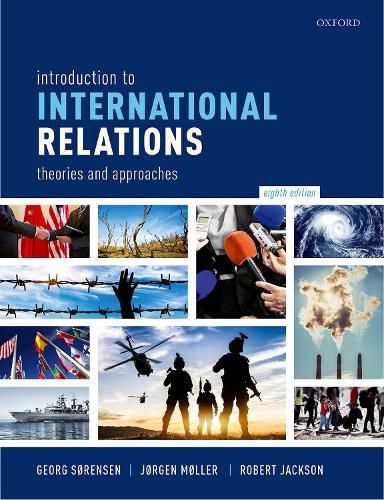Readings Newsletter
Become a Readings Member to make your shopping experience even easier.
Sign in or sign up for free!
You’re not far away from qualifying for FREE standard shipping within Australia
You’ve qualified for FREE standard shipping within Australia
The cart is loading…






Offering unrivalled coverage of classical theories, contemporary approaches, and current issues, together with an exceptionally clear writing style, Introduction to International Relations provides a uniquely accessible and engaging introduction to the subject. With an emphasis on theoretical approaches and their application to the real world, the authors encourage critical engagement with the theories presented, highlighting their strengths, weaknesses, and the major points of contention.The eighth edition has been thoroughly updated to incorporate current events and key developments in the discipline. The changes include a new, three-part structure, which helps students to build a clear understanding of how key debates in the discipline are connected with each other, and how these can be applied to the world around them. The first part, ‘Studying IR’, emphasises the practical reality of international relations in everyday life, and how to connect this reality with the academic study of the subject. The second part, ‘Major IR Theories and Approaches’, guides the reader through the essential theories in the field, including Realism, Liberalism, Social Constructivism, Postcolonialism, and Feminism, among others. Finally, the third part, ‘Theory Meets the Real World: Policy and Issues’, builds on this foundation by exploring how we can understand current issues such as climate change and terrorism through the lens of IR theory.A new final chapter, ‘The Big Question: World Order or World Chaos?’, concludes the text by tracing the development of, and theoretical debates around, the concept of ‘world order’, providing students with a nuanced and compelling analysis of the key challenges confronting the contemporary world. Opening with an overview of the concept, the authors go on to examine the consequences of the rise of China and the resurgence of Russian influence, the new issues facing established democracies and parts of the Global South, as well as international institutions and their ability to provide global governance. The chapter ends with a discussion that answers the question posed at the start: are we witnessing world order or world chaos?KEY FEATURESA truly accessible introduction to international relations, which demystifies the key theories, debates, and issuesIncludes up-to-date examples to help students link theory to real-world developmentsEncourages students to think critically by presenting the strengths and weaknesses of different theories and highlighting points of contention between themAlso available as an e-book with functionality, navigation features, and links that offer extra learning supportIn addition to helpful learning features within the book, the text is accompanied by online resources designed to help students to take learning further.
$9.00 standard shipping within Australia
FREE standard shipping within Australia for orders over $100.00
Express & International shipping calculated at checkout
Stock availability can be subject to change without notice. We recommend calling the shop or contacting our online team to check availability of low stock items. Please see our Shopping Online page for more details.
Offering unrivalled coverage of classical theories, contemporary approaches, and current issues, together with an exceptionally clear writing style, Introduction to International Relations provides a uniquely accessible and engaging introduction to the subject. With an emphasis on theoretical approaches and their application to the real world, the authors encourage critical engagement with the theories presented, highlighting their strengths, weaknesses, and the major points of contention.The eighth edition has been thoroughly updated to incorporate current events and key developments in the discipline. The changes include a new, three-part structure, which helps students to build a clear understanding of how key debates in the discipline are connected with each other, and how these can be applied to the world around them. The first part, ‘Studying IR’, emphasises the practical reality of international relations in everyday life, and how to connect this reality with the academic study of the subject. The second part, ‘Major IR Theories and Approaches’, guides the reader through the essential theories in the field, including Realism, Liberalism, Social Constructivism, Postcolonialism, and Feminism, among others. Finally, the third part, ‘Theory Meets the Real World: Policy and Issues’, builds on this foundation by exploring how we can understand current issues such as climate change and terrorism through the lens of IR theory.A new final chapter, ‘The Big Question: World Order or World Chaos?’, concludes the text by tracing the development of, and theoretical debates around, the concept of ‘world order’, providing students with a nuanced and compelling analysis of the key challenges confronting the contemporary world. Opening with an overview of the concept, the authors go on to examine the consequences of the rise of China and the resurgence of Russian influence, the new issues facing established democracies and parts of the Global South, as well as international institutions and their ability to provide global governance. The chapter ends with a discussion that answers the question posed at the start: are we witnessing world order or world chaos?KEY FEATURESA truly accessible introduction to international relations, which demystifies the key theories, debates, and issuesIncludes up-to-date examples to help students link theory to real-world developmentsEncourages students to think critically by presenting the strengths and weaknesses of different theories and highlighting points of contention between themAlso available as an e-book with functionality, navigation features, and links that offer extra learning supportIn addition to helpful learning features within the book, the text is accompanied by online resources designed to help students to take learning further.